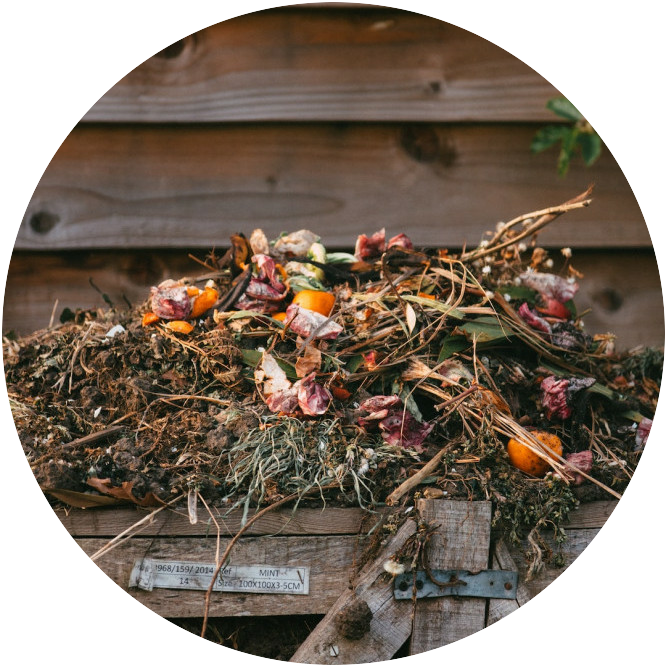I earn commissions if you shop through the links below at no additional cost to you.
Last Updated on February 29, 2024 by Jeremy
Affiliate Disclosure: In the spirit of full transparency, please note that this article contains affiliate links to products related to composting. If you make a purchase through these links, we may earn a small commission, which helps support our website. However, rest assured that we only recommend products we genuinely believe in and that can enhance your composting experience.

Composting might sound like a dirty endeavor, but it’s a simple and rewarding way to recycle organic waste into nutrient-rich soil for your garden.
Whether you’re a nature enthusiast like myself or simply looking to reduce your environmental footprint, composting is a step in the right direction.
In this “how to compost at home for beginners” guide, we’ll break down the basics of composting and help you get started on your journey to healthier, more sustainable gardening.
What is Composting?
At its core, composting is the process of decomposing organic materials to create a nutrient-rich soil conditioner.
The end result, often referred to as “black gold” by gardeners, is a dark, crumbly substance that’s packed with essential nutrients like nitrogen, phosphorus, and potassium.
This homemade soil amendment not only enriches your garden but also reduces the need for chemical fertilizers, making it an eco-friendly choice.
Materials for Composting
Composting is all about balance, and there are two main types of materials you’ll need to achieve that equilibrium: browns and greens.
 Brown materials are carbon-rich and include items like dried leaves, straw, and small twigs.
Brown materials are carbon-rich and include items like dried leaves, straw, and small twigs.
These materials provide structure to your compost pile and help with aeration. They should make up about 3/4 of your compost mix.
 Green materials, on the other hand, are nitrogen-rich and include things like grass clippings, vegetable scraps, and coffee grounds.
Green materials, on the other hand, are nitrogen-rich and include things like grass clippings, vegetable scraps, and coffee grounds.
Greens provide the necessary nitrogen for microorganisms to break down the organic matter. They should constitute the remaining 1/4 of your compost pile.
Composting Do’s and Don’ts
Now that you know what materials to use let’s dive deeper into what you should and shouldn’t compost.
Brown materials are generally straightforward. However, here are some tips to keep in mind:
- Avoid adding toxic or slow-to-decompose items, such as holly leaves or large wood products.
- Break down pine needles and wood into smaller pieces for quicker decomposition.
- Limit the use of wood ashes, as they are alkaline-based. A little goes a long way.
- Stay away from coal ashes and charcoal briquettes, as they can harm your plants and don’t decompose effectively.
 Green materials are more diverse. Here’s what you need to know:
Green materials are more diverse. Here’s what you need to know:
- Kitchen scraps like fruit and vegetable scraps, coffee grounds, and crushed eggshells are excellent additions.
- Garden waste, including dead plants, flower trimmings, and thinned seedlings, can be composted.
- Surprisingly, even weeds and their seeds can go into the compost pile, provided you maintain a high internal temperature (above 130 degrees Fahrenheit) to kill the seeds.
- Manure from herbivore animals like cows and sheep is a valuable green material. However, avoid fresh manure, as it’s too nutrient-rich for young plants. Aged manure is a better choice.
What Not to Compost
There are some definite no-nos when it comes to composting:
- Meat and dairy products: These can attract pests and produce unpleasant odors.
- High-fat items: Avoid composting foods like peanut butter and salad dressings, as they can lead to odors.
- Toxic plants: Be aware of poisonous plants in your area and avoid composting them. Some garden centers may sell toxic plants, so exercise caution.

The Composting Process
Creating your own nutrient-rich soil takes time, typically around a year. During this period, microorganisms, worms, and other helpful creatures break down the organic materials into compost.
Here’s a basic overview of the process:
- Collection: Start by collecting your brown and green materials in a dedicated compost bin or pile.
- Layering: Alternate between brown and green materials in layers. This helps maintain the right balance of carbon and nitrogen.
- Aeration: Turning or stirring your compost pile every couple of weeks promotes airflow and accelerates decomposition. Some compost bins are designed as tumblers, making this step a breeze.
- Temperature: Aim to keep the internal temperature of your compost pile above 130 degrees Fahrenheit to kill weed seeds and pathogens.
- Patience: Composting requires some patience, but the end result is well worth the wait. Your plants will thrive with the nutrient-rich compost you’ve created.
This book from Amazon is a great addition to this article: 
Choosing Your Composting Setup
The type of composting system you choose depends on your available space and needs:
- Tumbler or Stand Bin: Ideal for smaller spaces like balconies or urban gardens, these setups are efficient and easy to manage.
- Traditional Pile: If you have plenty of space, a simple compost pile can be an excellent choice. It’s low-cost and effective.
Final Thoughts
Composting is a rewarding and eco-friendly way to reduce waste and enhance your garden’s fertility. It’s a small step that can make a big difference in your gardening efforts.
So, whether you’re a seasoned gardener or a beginner, consider starting your composting journey today. Your plants—and the environment—will thank you for it.

Have Questions or Tips? We’d love to hear from fellow composters! Share your questions, tips, or experiences in the comments below.
Let’s grow together and make the Earth a little greener, one compost pile at a time.
Remember, Earth is Heart!






Hi Jeremy & Jessica.
I’ve always considered composting a daunting task and marvelled at the people who do it. However, you have broken it down into some easy-to-follow steps. I like the fact you not only tell us what we can use but also mention what NOT to use.
For coffee lovers, what a great way to use up those coffee grinds! Thanks for sharing this informative article. My husband and I are house sitters so having our own compost isn’t feasible but this information is great when we house-sit for those who do!
Thank you, I’m glad this article was informative for you about composting.
Yes, it’s amazing what the coffee grounds do for the earth, but I think my favorite is what egg shells can do for composting.